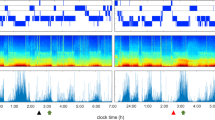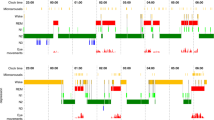Abstract
Objectives
Ayahuasca is a traditional South American psychoactive beverage and the central sacrament of Brazilian-based religious groups, with followers in Europe and the United States. The tea contains the psychedelic indole N,N-dimethyltryptamine (DMT) and β-carboline alkaloids with monoamine oxidase-inhibiting properties that render DMT orally active. DMT interacts with serotonergic neurotransmission acting as a partial agonist at 5-HT1A and 5-HT2A/2C receptor sites. Given the role played by serotonin in the regulation of the sleep/wake cycle, we investigated the effects of daytime ayahuasca consumption in sleep parameters.
Measurements and results
Subjective sleep quality, polysomnography (PSG), and spectral analysis were assessed in a group of 22 healthy male volunteers after the administration of a placebo, an ayahuasca dose equivalent to 1 mg DMT kg−1 body weight, and 20 mg d-amphetamine, a proaminergic drug, as a positive control. Results show that ayahuasca did not induce any subjectively perceived deterioration of sleep quality or PSG-measured disruptions of sleep initiation or maintenance, in contrast with d-amphetamine, which delayed sleep initiation, disrupted sleep maintenance, induced a predominance of ‘light’ vs ‘deep’ sleep and significantly impaired subjective sleep quality. PSG analysis also showed that similarly to d-amphetamine, ayahuasca inhibits rapid eye movement (REM) sleep, decreasing its duration, both in absolute values and as a percentage of total sleep time, and shows a trend increase in its onset latency. Spectral analysis showed that d-amphetamine and ayahuasca increased power in the high frequency range, mainly during stage 2. Remarkably, whereas slow-wave sleep (SWS) power in the first night cycle, an indicator of sleep pressure, was decreased by d-amphetamine, ayahuasca enhanced power in this frequency band.
Conclusions
Results show that daytime serotonergic psychedelic drug administration leads to measurable changes in PSG and sleep power spectrum and suggest an interaction between these drugs and brain circuits modulating REM and SWS.


Similar content being viewed by others
References
Aeschbach D, Borbély AA (1993) All-night dynamics of the human sleep EEG. J Sleep Res 2:70–81
Araneda R, Andrade R (1991) 5-Hydroxytryptamine2 and 5-hydroxytryptamine 1A receptors mediate opposing responses on membrane excitability in rat association cortex. Neuroscience 40:399–412
Barbanoj MJ, Clos S, Romero S, Morte A, Gimenez S, Lorenzo JL, Luque A, Dal-Re R (2005) Sleep laboratory study on single and repeated dose effects of paroxetine, alprazolam and their combination in healthy young volunteers. Neuropsychobiology 51:134–147
Blois R, Gaillard JM (1990) Effects of moclobemide on sleep in healthy human subjects. Acta Psychiatr Scand Suppl 360:73–75
Borbély AA, Baumann F, Brandeis D, Strauch I, Lehmann D (1981) Sleep deprivation: effect on sleep stages and EEG power density in man. Electroencephalogr Clin Neurophysiol 51:483–495
Borbély AA, Mattmann P, Loepfe M, Strauch I, Lehmann D (1985) Effect of benzodiazepine hypnotics on all-night sleep EEG spectra. Hum Neurobiol 4:189–194
Buckholtz NS, Boggan WO (1977a) Inhibition by beta-carbolines of monoamine uptake into a synaptosomal preparation: structure-activity relationships. Life Sci 20:2093–2099
Buckholtz NS, Boggan WO (1977b) Monoamine oxidase inhibition in brain and liver produced by beta-carbolines: structure-activity relationships and substrate specificity. Biochem Pharmacol 26:1991–1996
Callaway JC, McKenna DJ, Grob CS, Brito GS, Raymon LP, Poland RE, Andrade EN, Andrade EO, Mash DC (1999) Pharmacokinetics of Hoasca alkaloids in healthy humans. J Ethnopharmacol 65:243–256
Coull JT (1998) Neural correlates of attention and arousal: insights from electrophysiology, functional neuroimaging and psychopharmacology. Prog Neurobiol 55:343–361
Deliganis AV, Pierce PA, Peroutka SJ (1991) Differential interactions of dimethyltryptamine (DMT) with 5-HT1A and 5-HT2 receptors. Biochem Pharmacol 41:1739–1744
Driver HS, Taylor SR (2000) Exercise and sleep. Sleep Med Rev 4:387–402
Driver HS, Flanigan MJ, Bentley AJ, Luus HG, Shapiro CM, Mitchell D (1995) The influence of ipsapirone, a 5-HT1A agonist, on sleep patterns of healthy subjects. Psychopharmacology (Berl) 117:186–192
Feinberg I, Floyd TC (1979) Systematic trends across the night in human sleep cycles. Psychophysiology 16:283–291
Gillin JC, Jernajczyk W, Valladares-Neto DC, Golshan S, Lardon M, Stahl SM (1994) Inhibition of REM sleep by ipsapirone, a 5HT1A agonist, in normal volunteers. Psychopharmacology (Berl) 116:433–436
Gouzoulis E, Steiger A, Ensslin M, Kovar A, Hermle L (1992) Sleep EEG effects of 3,4-methylenedioxyethamphetamine (MDE; “eve”) in healthy volunteers. Biol Psychiatry 32:1108–1117
Green WJ (1965) The effect of LSD on the sleep-dream cycle. An exploratory study. J Nerv Ment Dis 140:417–426
Hicks JA, Argyropoulos SV, Rich AS, Nash JR, Bell CJ, Edwards C, Nutt DJ, Wilson SJ (2002) Randomised controlled study of sleep after nefazodone or paroxetine treatment in out-patients with depression. Br J Psychiatry 180:528–535
Johns MW (2002) Sleep propensity varies with behaviour and the situation in which it is measured: the concept of somnificity. J Sleep Res 11:61–67
Katsuda Y, Walsh AE, Ware CJ, Cowen PJ, Sharpley AL (1993) meta-Chlorophenylpiperazine decreases slow-wave sleep in humans. Biol Psychiatry 33:49–51
Lamas X, Farre M, Llorente M, Cami J (1994) Spanish version of the 49-item short form of the Addiction Research Center Inventory (ARCI). Drug Alcohol Depend 35:203–209
Landolt HP, Werth E, Borbely AA, Dijk DJ (1995) Caffeine intake (200 mg) in the morning affects human sleep and EEG power spectra at night. Brain Res 675:67–74
Landolt HP, Meier V, Burgess HJ, Finelli LA, Cattelin F, Achermann P, Borbely AA (1999) Serotonin-2 receptors and human sleep: effect of a selective antagonist on EEG power spectra. Neuropsychopharmacology 21:455–466
Martin WR, Sloan JW, Sapira JD, Jasinski DR (1971) Physiologic, subjective, and behavioral effects of amphetamine, methamphetamine, ephedrine, phenmetrazine, and methylphenidate in man. Clin Pharmacol Ther 12:245–258
McGinty DJ, Harper RM (1976) Dorsal raphe neurons: depression of firing during sleep in cats. Brain Res 101:569–575
Monti JM, Monti D (2000) Role of dorsal raphe nucleus serotonin 5-HT1A receptor in the regulation of REM sleep. Life Sci 66:1999–2012
Morgan MJ (2000) Ecstasy (MDMA): a review of its possible persistent psychological effects. Psychopharmacology (Berl) 152:230–248
Muzio JN, Roffwarg HP, Kaufman E (1966) Alterations in the nocturnal sleep cycle resulting from LSD. Electroencephalogr Clin Neurophysiol 21:313–324
Preud’homme XA, Lanquart JP, Mendlewicz J, Linkowski P (2000) Characteristics of spontaneous sleep with varying NREMS Episodes in healthy men: implication for delta activity homeostasis. Sleep 23:193–203
Rechtschaffen A, Kales A (1968) Techniques and scoring system for sleep stages in human subjects. US Government Printing Office, Washington, DC, USA
Riba J, Rodriguez-Fornells A, Strassman RJ, Barbanoj MJ (2001) Psychometric assessment of the Hallucinogen Rating Scale. Drug Alcohol Depend 62:215–223
Riba J, Anderer P, Morte A, Urbano G, Jane F, Saletu B, Barbanoj MJ (2002) Topographic pharmaco-EEG mapping of the effects of the South American psychoactive beverage ayahuasca in healthy volunteers. Br J Clin Pharmacol 53:613–628
Riba J, Valle M, Urbano G, Yritia M, Morte A, Barbanoj MJ (2003) Human pharmacology of ayahuasca: subjective and cardiovascular effects, monoamine metabolite excretion, and pharmacokinetics. J Pharmacol Exp Ther 306:73–83
Riba J, Romero S, Grasa E, Mena E, Carrio I, Barbanoj MJ (2006) Increased frontal and paralimbic activation following ayahuasca, the pan-Amazonian inebriant. Psychopharmacology (Berl) 186:93–98
Saletu B, Wesseley P, Grünberger J, Schultes M (1987) Erste klinische Erfahrungen mit einem neuen Schlafanstossenden Benzodiazepin Cinolazepam mittels eines Selbstbeurteilungsbögens für Schlaf- und Aufwachqualität (SSA). Neuropsychiatrie 1:169–176
Saletu B, Frey R, Krupka M, Anderer P, Grunberger J, Barbanoj MJ (1989) Differential effects of a new central adrenergic agonist-modafinil-and d-amphetamine on sleep and early morning behaviour in young healthy volunteers. Int J Clin Pharmacol Res 9:183–195
Saucier C, Morris SJ, Albert PR (1998) Endogenous serotonin-2A and -2C receptors in Balb/c-3T3 cells revealed in serotonin-free medium: desensitization and down-regulation by serotonin. Biochem Pharmacol 56:1347–1357
Schlösser R, Roschke J, Rossbach W, Benkert O (1998) Conventional and spectral power analysis of all-night sleep EEG after subchronic treatment with paroxetine in healthy male volunteers. Eur Neuropsychopharmacol 8:273–278
Schultes RE, Hofmann A (1987) Plants of the gods: origins of hallucinogenic use. van der Marck Editions, New York
Seifritz E, Moore P, Trachsel L, Bhatti T, Stahl SM, Gillin JC (1996) The 5-HT1A agonist ipsapirone enhances EEG slow wave activity in human sleep and produces a power spectrum similar to 5-HT2 blockade. Neurosci Lett 209:41–44
Sharpley AL, Elliott JM, Attenburrow MJ, Cowen PJ (1994) Slow wave sleep in humans: role of 5-HT2A and 5-HT2C receptors. Neuropharmacology 33:467–471
Sprouse JS, Aghajanian GK (1987) Electrophysiological responses of serotoninergic dorsal raphe neurons to 5-HT1A and 5-HT1B agonists. Synapse 1:3–9
Torda C (1968) Contribution to serotonin theory of dreaming (LSD infusion). N Y State J Med 68:1135–1138
Acknowledgements
The authors thank the staff at the Centre d’Investigació de Medicaments de l’Institut de Recerca de l’Hospital de la Santa Creu i Sant Pau, in particular Adelaida Morte, Llúcia Benito, David Martínez and Liria da Graça for their technical assistance during data collection and Angeles Funes for copy-editing the manuscript. The present research complies with Spanish law. This study was supported by a grant from the Spanish Ministry of Education and Science (SAF 2002-02746) and by the Spanish Ministry of Health, Instituto de Salud Carlos III, RETICS RD06/0011 (REM-TAP Network).
Author information
Authors and Affiliations
Corresponding author
Rights and permissions
About this article
Cite this article
Barbanoj, M.J., Riba, J., Clos, S. et al. Daytime Ayahuasca administration modulates REM and slow-wave sleep in healthy volunteers. Psychopharmacology 196, 315–326 (2008). https://doi.org/10.1007/s00213-007-0963-0
Received:
Accepted:
Published:
Issue Date:
DOI: https://doi.org/10.1007/s00213-007-0963-0




